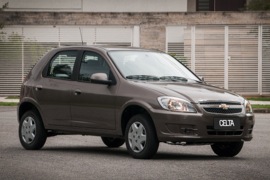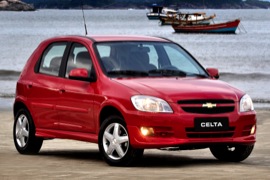CHEVROLET Celta Models/Series Timeline, Specifications & Photos
First production year: 2000
Engines: Gasoline
Body style: Hatchback
General Motors took an Opel/Vauxhall Corsa from Europe, slammed a new front fascia with inspiration from the Vectra lineup, and mounted a bow-tie badge at the front. And that's how the Chevrolet Celta was born.
The third generation of the Corsa was a European hit, and GM needed that success exported to other countries. The car made it to the South-American continent and was re-badged as a Chevrolet Celta with a new face and different engines, and the market warmly received it.
Dye to its Vectra-like headlights and grille, the little 5-door Celta looked more serious. The designers included a small and narrow, vertical side window in the C-pillar right behind the rear doors. That was a specific design element for the little GM vehicle in the small-segment. To protect the taillights from scratches and parking bumps, they were installed on the C-pillars.
Inside, the car featured good amenities for its segment, even though the base model didn't feature power-windows or air-conditioning. The Celta was fitted with a sound system with a CD player, an on-board computer, and four power-windows moving up to the trim level and options list.
The Celta was available with three engine choices with gasoline or flex-fuel system. Its base version provided 60 hp, from a 1.0-liter displacement. For specific markets, GM installed a 1.4-liter engine to cope better with high altitudes.
General Motors needed a cheap vehicle for the South-American market, and instead of creating a new one, it took the European Vauxhall/Opel Corsa and changed its front fascia, adding a Chevrolet badge on it and the Celta nameplate on the back.
GM was confident that the car would sell well since it already knew that the Corsa's third generation was a top-selling vehicle. Furthermore, since the development costs were already covered, it meant that the Celta could have been sold at a lower cost. And that's what it did. In addition, Chevrolet sold the vehicle as a three or five-door hatchback.
With its bigger headlights and the one-slat grille up front, the Celta looked like it was ready for anything one could ask from a small-sized car. Its front doors were longer than on the five-door version, making the ingress and egress easier for rear passengers. At the back, the taillights were mounted on the sides of the tailgate, way above the bumper, to protect them from small parking bumps.
Inside, the car featured good amenities for its segment, even though the base model didn't feature power windows or air-conditioning. Yet, the comfortable seats and the folding rear bench offered enough room for four adults, but not for very long trips. To help cool the cabin, the carmaker installed pop-out windows for the rear passengers.
The Celta was available with three engine choices with gasoline or flex-fuel system. Its base version provided 60 hp from a 1.0-liter displacement. For specific markets, GM installed a 1.4-liter engine to cope better with high altitudes.

